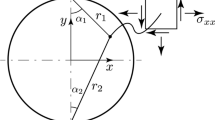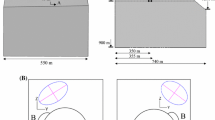Abstract
This paper presents a back analysis procedure for identification of the elastic parameters of transversely isotropic rock cores, containing an overcoring triaxial strain probe, from the strains measured during a biaxial test. A three-dimensional finite element model was developed to simulate the biaxial test on the overcored rock specimen and to compute the strains at the location of the strain gauges. Different optimisation algorithms were tested and the most suitable one was selected. The back analysis procedure was tested for identification of the five elastic parameters and the two orientation angles that characterise a transversely isotropic rock core. Despite that, with the developed methodology, convergence was reached and all those parameters could be identified, sensitivity analyses demonstrated that the results obtained were not stable, and therefore, they were not reliable. By introducing constrains based on common practice and previous experience, a stable and robust methodology was achieved: the three elastic parameters, E 1, E 2 and ν 2, are reliably identified using the value of G 2 calculated with Saint–Venant expression and a fixed value of ν 1, while the orientation parameters are obtained from observation of overcored rock. Analysis of the results shows that application of this methodology represents an enormous step forward when compared with the traditional use of isotropy. Besides, the methodology is general and can also be used with other types of overcoring equipment. The five elastic parameters and the two orientation angles obtained can then be used, together with the overcoring strains, to compute the complete in situ state of stress.










Similar content being viewed by others
References
Amadei B (1983) Rock anisotropy and the theory of stress measurements. Lecture notes in engineering, Springer, Berlin
Amadei B (1984) In situ stress measurements in anisotropic rock. Int J Rock Mech Min Sci 21(6):327–338
Amadei B (1996) Importance of anisotropy when estimating and measuring in situ stresses in rock. Int J Rock Mech Min Sci 33(3):293–325
Amadei B, Stephansson O (1997) Rock stress and its measurements. Chapman and Hall Publication, London
Amadei B, Savage WZ, Swolfs HS (1987) Gravitational stresses in anisotropic rock masses. Int J Rock Mech Min Sci Geomech Abstr 24:5–14
Chen CS, Pan E, Amadei B (1998) Determination of the deformability and tensile strength of anisotropic rock using Brazilian tests. Int J Rock Mech Min Sci 35:43–61
Cho J-W, Kim H, Jeon S, Min K-B (2012) Deformation and strength anisotropy of Asan gneiss, Boryeong shale, and Yeoncheon schist. Int J Rock Mech Min Sci 50:158–169
Cividini A, Jurina L, Gioda G (1981) Some aspects of characterization problems in geomechanics. Int J Rock Mech Mining Sci 18:487–503
Cornet FH (1993) Stress in rock and rock masses. Comprehensive Rock Engineering, Vol. 3, Hudson J (ed). Pergamon Press, Oxford, pp. 297–327
Espada M, Lamas L (2016) Identification of transversely isotropic parameters in overcored rock specimens—a back analysis approach. ICT Publication, LNEC, Lisbon
Fairhurst C (2003) Stress estimation in rock: a brief history and review. Int J Rock Mech Min Sci 40:957–973
Figueiredo B, Lamas L, Muralha J (2009) Numerical modelling for interpretation of stress measurements by overcoring. ISRM International Symposium on Rock Mechanics—SINOROCK, 19–22 May, The University of Hong Kong, China
Gercek H (2007) Poisson’s ratio values for rocks. Int J Rock Mech Min Sci 44:1–13
Gill PE, Murray W, Wright MH (1981) Practical optimization. Academic Press, London
Gioda G, Sakurai S (1987) Back analysis procedures for the interpretation of field measurements in geomechanics. Int J Num Anal Methods Geomech 11:555–583
Gonzaga GG, Leite MH, Corthésy R (2008) Determination of anisotropic deformability parameters from a single standard rock specimen. Int J Rock Mech Min Sci 45(8):1420–1438
Hallbjörn L (1986) Rock stress measurements performed by Swedish State Power Board. In: Proceedings of International Symposium on Rock Stress and Rock Stress Measurements, Stockholm, Centek Publ. Luleå, pp. 197–205
Hiltscher R, Martna J, Strindell L (1979) The measurement of triaxial rock stresses in deep holes and the use of rock stress measurements in the design and construction of rock openings. In: Proceedings of 4th Congress International Society for Rock Mechanics (ISRM), Montreaux, Balkema, Rotterdam, Vol 2, pp. 227–34
Hudson JA, Cornet FH, Christiansson R (2003) ISRM Suggested methods for rock stress estimation—Part 1: strategy for rock stress estimation. Int J Rock Mech Min Sci 40:991–998
Ledesma A, Gens A, Alonso EE (1996) Parameter and variance estimation in geotechnical backanalysis using prior information. Int J Num Anal Methods Geomech 20:119–141
Leeman ER (1971) The CSIR doorstopper and triaxial rock stress measuring instruments. Rock Mech 3:25–50
Lekhnitskii SG (1963) Theory of elasticity of an anisotropic elastic body. In: Brandstatter JJ (ed) Holdenday series in mathematical physics. Holden Day Inc, San Francisco
Ljunggren C, Chang Y, Janson T, Christianson R (2003) An overview of rock stress measurement methods. Int J Rock Mech Min Sci 40:975–989
MathWorks (2011) The Language of Technical Computing, Version 7.13 (R2011b). User Manual., MathWorks Inc
Merrill RH (1967) Three component borehole deformation gauge for determining the stress in rock. USBM RI7015
Muralha J (2008) Geomechanical characterization tests for the rock mass of the new powerhouse of the Bemposta dam (in Portuguese). Report 296/2008-NFOS, LNEC, Lisboa
Nunes ALLS (2002) A new method for determination of transverse isotropic orientation and the associated elastic parameters for intact rock. Int J Rock Mech Min Sci 39:257–273
Papon A, Riou Y, Dano C, Hicher P-Y (2011) Single-and multi-objective genetic algorithm optimization for identifying soil parameters. J Num Anal Methods Geomech Int. doi:10.1002/nag.1019
Pedro O, França V (1972) Study of the deformations of a plastic cylinder placed inside a rock mass (“Strain Tensor Tube”) (in Portuguese). Internal report, LNEC, Lisbon
Pinto JL (1979) Determination of the elastic constants of anisotropic bodies by diametral compression tests. In: Proceedings of the Fourth International Congress on Rock Mechanics, Montreux, pp. 359–363
Pinto JL (1983) Deformability of rock masses (in Portuguese). Research Programme, LNEC, Lisbon
Pinto JL, Cunha AP (1986) Rock stress determinations with the STT and SFJ techniques. In: Proceedings of International Symposium on Rock Stress and Rock Stress Measurements, Stockholm, pp. 253–260
Powell MJD (1978) A Fast Algorithm for Nonlinearly Constrained Optimization Calculations. In: Watson GA (ed) Numerical Analysis., Lecture Notes in Mathematics. Springer Verlag, New York
Rocha M, Silvério A (1969) A new method for the complete determination of the state of stress in rock masses. Géotecnique 19:116–132
Sakurai S, Takeuchi K (1983) Back analysis of measured displacements of tunnels. Rock Mech Rock Eng 16(3):173–180
Sousa LR, Martins CS, Lamas LN (1986) Development of the techniques of measurement and interpretation of the state of stress in rock masses. Proceedings of the IAEG International Congress, Buenos Aires
Talesnick ML, Ringel M (1999) Completing the hollow cylinder methodology for testing of transversely isotropic rocks: torsing testing. Int Journal of Rock Mech Min Sci 36:627–639
Talesnick ML, Lee MY, Haimson BC (1995) On the determination of elastic material parameters for transverse isotropic rocks from a single test specimen. Rock Mech Rock Eng 28:17–36
Tavares de Castro A (1998) Back analysis methods in the interpretation of concrete dams behaviour (in Portuguese). Ph.D. thesis, Technical University of Lisbon
Wittke W (1990) Rock mechanics: theory and applications with case histories. Springer-Verlag, Berlin, New York, Tokyo
Worotnicki G (1993) CSIRO Triaxial stress measurement cell. In: Hudson JA (ed) Comprehensive rock engineering, vol 3. Pergamon Press, Oxford, pp 329–394
Worotnicki G, Walton RJ (1976) Triaxial hollow inclusions gauges for the determination of rock stress in situ. In Proceedings of ISRM Symposium on Investigation of Stress in Rock and Advances in Stress Measurement. Supplement, Sydney, pp. 1–8
Zang A, Stephansson O (2010) Stress field of the earth’s crust. Springer, Berlin. ISBN 978-1-4020-8444-7
Zentar R, Hicher P, Moulin G (2001) Identification of soil parameters by inverse analysis. Comput Geotech 28:129–144
Author information
Authors and Affiliations
Corresponding author
Rights and permissions
About this article
Cite this article
Espada, M., Lamas, L. Back Analysis Procedure for Identification of Anisotropic Elastic Parameters of Overcored Rock Specimens. Rock Mech Rock Eng 50, 513–527 (2017). https://doi.org/10.1007/s00603-016-1129-3
Received:
Accepted:
Published:
Issue Date:
DOI: https://doi.org/10.1007/s00603-016-1129-3




